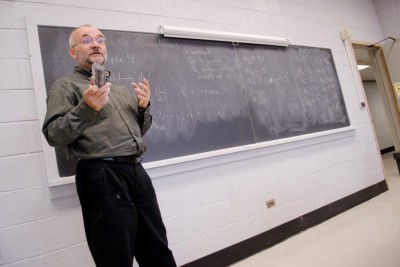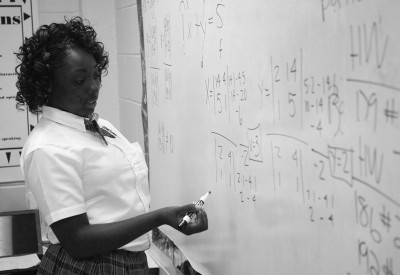
Remedial Math at Bronx Community College in New York City (Photo by Ryan Brenizer)
In an important piece in yesterday’s Lansing (Mich.) State Journal, Matthew Miller looked at remedial math classes taught at the community college level. These are courses that teach such basics as graphing y=2x+5 or solving for x in the equation x2 + 2x = 8. (Readers uncertain how to solve for x in the equation x2 + 2x = 8 can find the solution at the end of this post.) Remedial math, then, consists of things typically taught — but not necessarily learned — in elementary and middle-school math courses.
Nationwide, a majority of incoming community college students find themselves in remedial courses after taking placement exams that show they didn’t master the basics many years before — or that they’ve forgotten the basics. Math has long proven a greater stumbling block than English for most of these students. Miller quotes Kay McClenney, director of the Center for Community College Student Engagement at the University of Texas-Austin, as saying that remedial math “is without question the most significant problem facing American community colleges and maybe American higher education more broadly.”
It is a problem so big, in fact, that it’s sometimes overlooked. In its immensity and obviousness, it falls victim to what could be called the “everybody-somebody-anyb0dy-nobody mentality”:
There’s an important job to be done, and everybody’s sure somebody’ll do it. Anybody can do it, but nobody does. Somebody gets angry because it’s everybody’s job. Everybody thought anybody could do it, but nobody realized everybody wouldn’t do it. Everybody blamed somebody when nobody did what anybody could’ve done.
And so the problem continues and the costs mount. As Miller writes, the costs “can be calculated, not just in tuition dollars, but in degrees left unfinished and careers that never begin.”
But Lansing Community College (LCC) — where over 5,000 students took a remedial math class last year — is determined to change this. According to Miller, LCC has “retooled a computer assisted self-study program meant to prepare students for that most basic remedial math course, adding a human being to the mix. Prior to the change, 3 percent of the students who used the program managed to place into Math 050. Since April, it has been 21 percent.”
And, in a move that might at first seem counterintuitive, LCC shut down its Math Lab. Miller explains: the Lab “let students work at their own pace with help from tutors. Barely half of them passed, which is why LCC closed the lab this summer and carried over the format into smaller classes taught by a single instructor. ‘Personal connections that students make with instructors are particularly important in developmental courses,’ [Kathy] Burgis [chair of the Math Department] said. ‘Ideally, those courses are about more than just the math. They’re about general transferable skills in going to college.'”
Other community colleges around the nation are also trying out new strategies. Earlier this summer, Elizabeth Redden detailed a new approach by the math faculty at Bergen Community College in New Jersey.
And, of course, there’s merit to the notion that our country’s math woes begin long before students reach high school or community college. Last year, my colleagues and I at the Hechinger Institute looked at where the U.S. stands in math education and what the country could be doing differently, and we invite you to explore this important topic with us.
———
As promised, here’s the solution to the equation x2 + 2x = 8.
First, this equation can be rewritten as x2 + 2x – 8 = 0. Then, it can be factored: (x-2)(x+4) = 0.
Finally, each of these “mini-” equations can be set equal to zero — i.e, x-2 = 0 and x+4 = 0. Thus, x in this equation is either 2 or -4. To double-check your work, plug these numbers back in to the original equation and see if they work out. Substituting 2 for x, I get 22 + 2(2) = 8, or 4+4 = 8, which checks out. Substituting -4 for x, I get (-4)2 + 2(-4) = 8, or 16 + -8 = 8, which also checks out.




